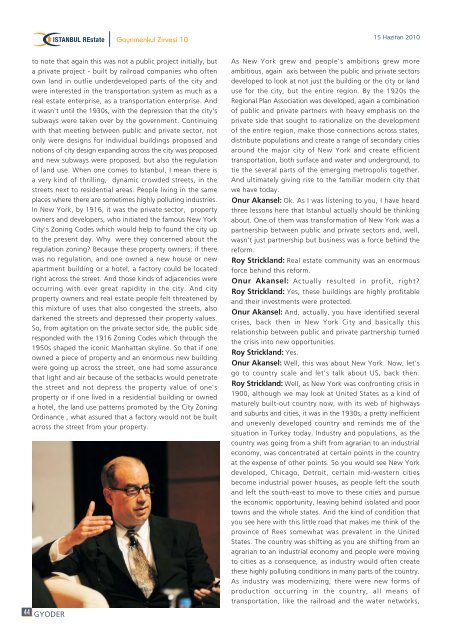Zirve Eki - ISTANBUL REstate
Zirve Eki - ISTANBUL REstate
Zirve Eki - ISTANBUL REstate
Create successful ePaper yourself
Turn your PDF publications into a flip-book with our unique Google optimized e-Paper software.
44 GYODER<br />
Gayrimenkul <strong>Zirve</strong>si 10<br />
to note that again this was not a public project initially, but<br />
a private project - built by railroad companies who often<br />
own land in outlie underdeveloped parts of the city and<br />
were interested in the transportation system as much as a<br />
real estate enterprise, as a transportation enterprise. And<br />
it wasn't until the 1930s, with the depression that the city's<br />
subways were taken over by the government. Continuing<br />
with that meeting between public and private sector, not<br />
only were designs for individual buildings proposed and<br />
notions of city design expanding across the city was proposed<br />
and new subways were proposed, but also the regulation<br />
of land use. When one comes to Istanbul, I mean there is<br />
a very kind of thrilling, dynamic crowded streets, in the<br />
streets next to residential areas. People living in the same<br />
places where there are sometimes highly polluting industries.<br />
In New York, by 1916, it was the private sector, property<br />
owners and developers, who initiated the famous New York<br />
City's Zoning Codes which would help to found the city up<br />
to the present day. Why were they concerned about the<br />
regulation zoning? Because these property owners; if there<br />
was no regulation, and one owned a new house or new<br />
apartment building or a hotel, a factory could be located<br />
right across the street. And those kinds of adjacencies were<br />
occurring with ever great rapidity in the city. And city<br />
property owners and real estate people felt threatened by<br />
this mixture of uses that also congested the streets, also<br />
darkened the streets and depressed their property values.<br />
So, from agitation on the private sector side, the public side<br />
responded with the 1916 Zoning Codes which through the<br />
1950s shaped the iconic Manhattan skyline. So that if one<br />
owned a piece of property and an enormous new building<br />
were going up across the street, one had some assurance<br />
that light and air because of the setbacks would penetrate<br />
the street and not depress the property value of one's<br />
property or if one lived in a residential building or owned<br />
a hotel, the land use patterns promoted by the City Zoning<br />
Ordinance , what assured that a factory would not be built<br />
across the street from your property.<br />
15 Haziran 2010<br />
As New York grew and people's ambitions grew more<br />
ambitious, again axis between the public and private sectors<br />
developed to look at not just the building or the city or land<br />
use for the city, but the entire region. By the 1920s the<br />
Regional Plan Association was developed, again a combination<br />
of public and private partners with heavy emphasis on the<br />
private side that sought to rationalize on the development<br />
of the entire region, make those connections across states,<br />
distribute populations and create a range of secondary cities<br />
around the major city of New York and create efficient<br />
transportation, both surface and water and underground, to<br />
tie the several parts of the emerging metropolis together.<br />
And ultimately giving rise to the familiar modern city that<br />
we have today.<br />
Onur Akansel: Ok. As I was listening to you, I have heard<br />
three lessons here that Istanbul actually should be thinking<br />
about. One of them was transformation of New York was a<br />
partnership between public and private sectors and, well,<br />
wasn't just partnership but business was a force behind the<br />
reform.<br />
Roy Strickland: Real estate community was an enormous<br />
force behind this reform.<br />
Onur Akansel: Actually resulted in profit, right?<br />
Roy Strickland: Yes, these buildings are highly profitable<br />
and their investments were protected.<br />
Onur Akansel: And, actually, you have identified several<br />
crises, back then in New York City and basically this<br />
relationship between public and private partnership turned<br />
the crisis into new opportunities.<br />
Roy Strickland: Yes.<br />
Onur Akansel: Well, this was about New York. Now, let's<br />
go to country scale and let's talk about US, back then.<br />
Roy Strickland: Well, as New York was confronting crisis in<br />
1900, although we may look at United States as a kind of<br />
maturely built-out country now, with its web of highways<br />
and suburbs and cities, it was in the 1930s, a pretty inefficient<br />
and unevenly developed country and reminds me of the<br />
situation in Turkey today. Industry and populations, as the<br />
country was going from a shift from agrarian to an industrial<br />
economy, was concentrated at certain points in the country<br />
at the expense of other points. So you would see New York<br />
developed, Chicago, Detroit, certain mid-western cities<br />
become industrial power houses, as people left the south<br />
and left the south-east to move to these cities and pursue<br />
the economic opportunity, leaving behind isolated and poor<br />
towns and the whole states. And the kind of condition that<br />
you see here with this little road that makes me think of the<br />
province of Rees somewhat was prevalent in the United<br />
States. The country was shifting as you are shifting from an<br />
agrarian to an industrial economy and people were moving<br />
to cities as a consequence, as industry would often create<br />
these highly polluting conditions in many parts of the country.<br />
As industry was modernizing, there were new forms of<br />
production occurring in the country, all means of<br />
transportation, like the railroad and the water networks,


